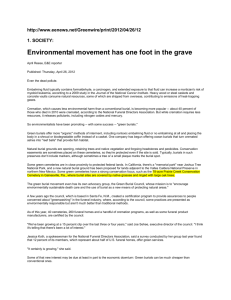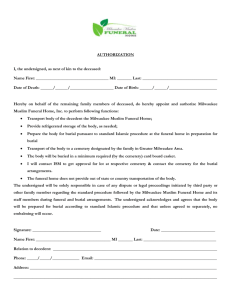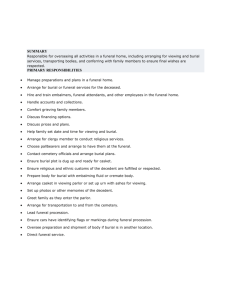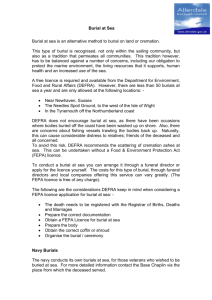Shades of Green
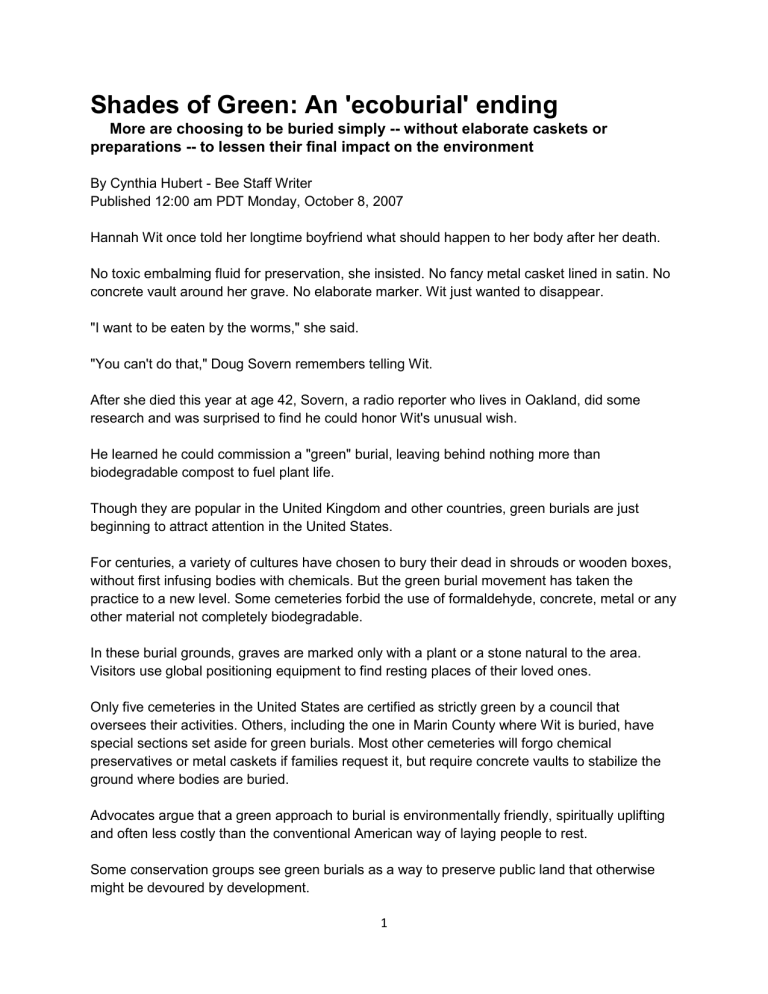
Shades of Green: An 'ecoburial' ending
More are choosing to be buried simply -- without elaborate caskets or preparations -- to lessen their final impact on the environment
By Cynthia Hubert - Bee Staff Writer
Published 12:00 am PDT Monday, October 8, 2007
Hannah Wit once told her longtime boyfriend what should happen to her body after her death.
No toxic embalming fluid for preservation, she insisted. No fancy metal casket lined in satin. No concrete vault around her grave. No elaborate marker. Wit just wanted to disappear.
"I want to be eaten by the worms," she said.
"You can't do that," Doug Sovern remembers telling Wit.
After she died this year at age 42, Sovern, a radio reporter who lives in Oakland, did some research and was surprised to find he could honor Wit's unusual wish.
He learned he could commission a "green" burial, leaving behind nothing more than biodegradable compost to fuel plant life.
Though they are popular in the United Kingdom and other countries, green burials are just beginning to attract attention in the United States.
For centuries, a variety of cultures have chosen to bury their dead in shrouds or wooden boxes, without first infusing bodies with chemicals. But the green burial movement has taken the practice to a new level. Some cemeteries forbid the use of formaldehyde, concrete, metal or any other material not completely biodegradable.
In these burial grounds, graves are marked only with a plant or a stone natural to the area.
Visitors use global positioning equipment to find resting places of their loved ones.
Only five cemeteries in the United States are certified as strictly green by a council that oversees their activities. Others, including the one in Marin County where Wit is buried, have special sections set aside for green burials. Most other cemeteries will forgo chemical preservatives or metal caskets if families request it, but require concrete vaults to stabilize the ground where bodies are buried.
Advocates argue that a green approach to burial is environmentally friendly, spiritually uplifting and often less costly than the conventional American way of laying people to rest.
Some conservation groups see green burials as a way to preserve public land that otherwise might be devoured by development.
1
"Before the 'better dying through chemistry' era was born, this was the way most of humanity cared for its dead," said Joe Sehee, founder and executive director of the Green Burial Council, a nonprofit group leading the charge for biodegradable burials. "It's a way to honor the dead and heal the living in an environmentally responsible manner."
Sehee's group believes metal caskets and reinforced concrete vaults are wasteful and unnecessary, and that formaldehyde used for embalming contributes to underground water pollution. The U.S. Environmental Protection Agency considers formaldehyde toxic to humans and other species, but the agency has no data on its potential for polluting water.
Cremations, Sehee noted, send potentially toxic mercury and other chemicals into the air from the burning of dental fillings. The EPA estimates that crematoriums emit about 320 pounds of mercury each year, a tiny share of the tons of the chemical pumped into the atmosphere by other industrial sources.
Conventional funeral directors challenge the notion that their methods are environmentally damaging. Funeral homes and cemeteries are required to abide by environmental laws, they point out. Moreover, they argue, many people want loved ones embalmed so that they are suitable for viewing before burial, and wish to honor them with fancy caskets and gravestones.
"I look at our cemetery, and to me it's a peaceful place where people can visit a grave site, bring flowers, have picnics," said Shaun Myers, a Utah funeral director and member of the National
Funeral Directors Association' s executive board. "To me it's a thing of beauty, and I don't see any documentation that supports the claim that cemeteries are places of contamination."
Most funeral directors are happy to conduct "direct burials," without embalming or elaborate caskets, if families request them, Myers said.
"The funeral directors that I know simply want to serve the family and the family's desires," he said.
In the Sacramento area, funeral homes frequently get requests for burial without embalming, said funeral director Tom Maloney of Lombard & Co. Biodegradable caskets are an option. But most cemeteries require concrete vaults to prevent graves from settling and sinking. Maloney said he doesn't know of any with areas dedicated to green burials.
"Ecoburials" have been slow to take off in the United States, Sehee said, in part because they pose an economic threat to funeral homes and cemeteries.
Green burials can be cheaper. The average cost of a traditional funeral is about $7,000, not including cemetery fees, which can add thousands of dollars to the bill. Green burials can be done for less than half that amount, advocates say.
"Still, we think funeral homes can make just as much money being more ethical and
2
environmentally sustainable," Sehee said. "The smarter providers realize that this is where the market is going."
Sehee's group certifies and oversees activities of the nation's green burial grounds and reviews green services offered by conventional funeral homes and cemeteries.
Meanwhile, the council is working with conservation groups such as the Commonweal
Conservancy and the Trust for Public Land to establish natural burial sites on property protected from future development.
"Burying someone in a certain place creates a feeling of sacredness, a connection to that land," said Ernest Cook, senior vice president of the Trust for Public Land. "As people choose green burial, we have the opportunity to communicate to them something about the place they are saving. It's a way for people to contribute to the conservation effort."
Ramsey Creek Preserve in South Carolina is among five areas the council has certified as green burial grounds. Others are in New York, Florida, New Mexico and Texas.
At Ramsey Creek, all graves are dug by hand. The dead are buried in a natural wooded area in shrouds or plain wooden boxes, without a vault or grave liner, according to the cemetery's Web site.
There are no rows of headstones. Many graves have no markers at all. Instead of placing cut flowers on graves, families are invited to plant a tree or shrub native to the area.
Other cemeteries in the United States are promoting green practices and ecoburials but don't meet all standards required to be certified, Sehee said.
Forever Fernwood Natural Burial Ground in Marin County is one such place.
Tyler Cassity's Forever Enterprises bought the property in 2004. It is adjacent to the Golden
Gate National Recreation Area and contains an old cemetery. Since then, about 120 people have been buried in a part of the property set aside for "natural" burial, said general manager
Nickolas Careone.
Some at Forever Fernwood choose shrouds or even cardboard boxes for burial. But a plain pine box without nails, screws or polyester lining is the most common receptacle, Careone said.
Because of high land values in the area, a natural burial spot at Forever Fernwood is not necessarily cheap, Careone said. For a price ranging from $6,000 to $16,000, customers buy an
"interment right" to the property that they carry forever.
Beyond its conventional cemetery, the green burial area looks like a placid meadow with trees, wildflowers and natural grasses. Clients are free to mark sites with native rocks, plants or trees.
3
The burial ground is wild nature, just the kind of place Hannah Wit would have appreciated,
Sovern said of his longtime companion, who spent countless hours hiking and biking around the
Bay Area.
"When I saw it I thought, 'This is perfect,' " Sovern recalled. "It is unbelievably beautiful."
Wit, who committed suicide in July, is buried on a wind-swept hill, close to the ocean and Mount
Tamalpais. When her loved ones arrived at the site after a short indoor memorial service, they spotted a flock of wild peacocks and a baby deer. A hawk soared overhead. Wit's beloved dog
Mujo sat at attention as her body was lowered into the ground.
"Hannah was a very special person," Sovern said. "She was into nature. She was a vegetarian and very organic. She loved animals and she cared about people. In the end, I felt that we did the right thing for her.
"It was exactly what she would have wanted."
Copyright © The Sacramento Bee
*** NOTICE: In accordance with Title 17 U.S.C. Section 107, this material is distributed, without profit, for research and educational purposes only. ***
4
